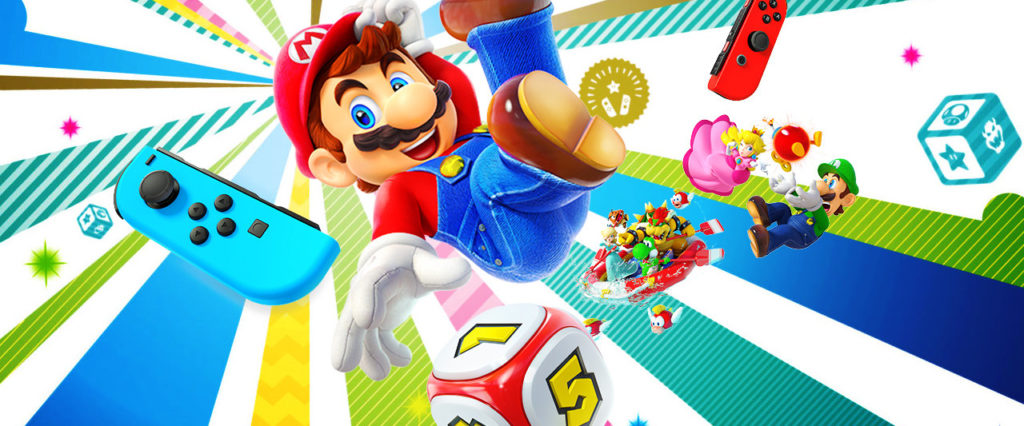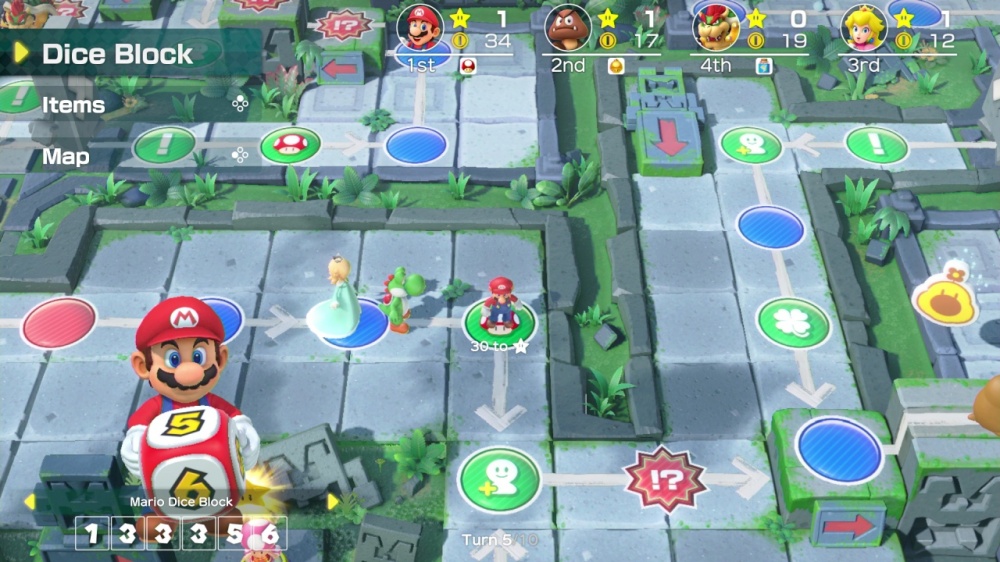I’ve played Mario Party games off and on in the past. Sometimes I even enjoyed them. When you’re with a group of friends or family, and the down-time between turns and minigames doesn’t matter as much, they’re a great background game.

As a parent to a child who loves playing them, I have officially played enough Mario Party. The good news, for you, is that I have played enough Mario Party on the Switch to go in-depth on which one you should play, when you would really rather be playing anything else.
Super Mario Party
Although it’s a few years old now, there are several points in Super Mario Party’s favor. It has a large variety of gameplay modes – including 2v2 and 4-player co-operative modes, in case your gameplay companion is really insistent about winning. All of the board game modes are slightly more strategic – though obviously nowhere near Civilization VI – thanks to the differentiation of characters by their custom dice blocks. Some dice blocks are relatively boring – like Mario’s, which rolls slightly more 3s than normal – but others are more interesting, like one that can roll only 4 or 0, or those that have high-risk numbers (⅔ chance of a 6, ⅓ chance of losing money and 0). Each turn you have the option of rolling either a standard 1-6 die, or using one of your custom dice blocks (either your chosen character’s or an acquired ally’s).

The standard Mario Party board game mode should be familiar to those who played the original trilogy of games, since it’s a throwback and didn’t integrate any of the more recent car-or-Bowser nonsense. Unfortunately, it didn’t take any of the important lessons from Culdcept. Mario Party could really use a stock market so you can gradually undermine Rosalina when she keeps getting hidden blocks. Anyway, one feature new to this game is the addition of allies acquired via landing on special spaces or as items, which offer both a passive (+1-2 movement per roll) and active (you can choose their dice block) bonus. In a long-term game, this can be a substantial advantage – although selecting from two or three dice blocks never quite matches up to the sublime experience of gradually dismantling the Holy Roman Empire in Europa Universalis IV. Take that, von Habsburgs!
The new cooperative mode, River Survival, is a fast-paced motion based river rafting game punctuated by the occasional cooperative minigame. While it may not be Left 4 Dead, I do have to give Nintendo some props for taking a game already notorious for causing family arguments and adding a cooperative mode that practically requires yelling at your teammates to start (or stop) paddling. Most of the cooperative minigames are actually pretty fun, and you can’t ever lose any time in the rafting mode for a poor performance.

Super Mario Party’s 2v2 mode is both a positive and a negative. In this mode, each board is effectively a grid. After both players on a team roll the dice, their results are added together (with modifiers for allies and items) and then both team members can pick their desired route. Although this offers much more freedom than the typical one-way Mario Party map, it becomes very frustrating – almost as frustrating as those archer knights on the Anor Londo rooftops in Dark Souls – when the star is only actually present on one tile of the grid and neither player can stop on that tile due to rolling odd/even numbers.
The other modes in Super Mario Party, like Challenge Road and the Rec Room, may be interesting if you find the minigames engaging, but Challenge Road certainly doesn’t measure up for those who have endured the prisons of Latria or survived to their second lantern in Yharnam.
One final note about Super Mario Party – it requires you to play with a single joy-con to support motion control in many game modes. If this sounds uncomfortable, you should try a Dreamcast controller.
Mario Party Superstars
The more recent Superstars release is a sort of “best of” of the Mario Party series. It has boards from the N64 entries (unfortunately no boards based on the actual best N64 game, Paper Mario) and games pulled from all numbered entries in the series. Alongside these changes is online play (board game or minigame modes), support for any Switch-compatible controller, and the ability to tweak game modes to, for example, remove bonus stars or place restrictions on them. It’s not as configurable as Skyrim mods, but then, what is?

As far as the board game mode is concerned, this is probably the best core iteration that still feels like the original trilogy. It runs faster than most and allows for resuming a partially completed game – although I do miss having drop-in / drop-out mechanics. The boards have been revised a bit from their respective originals, but still have pretty similar gimmicks – although most err on the side of being more complicated than they need to be, and seem designed for longer (20+ turn) games that would take over an hour to complete. And given the choice between an hour of Mario Party and an hour of Shin Megami Tensei: Nocturne, I know which one I would rather play and then wipe out, losing all progress due to a stray Mudo.
The selection of minigames is also pretty good – although it surprisingly includes a few button-mashing games (1v3 tug of war being particularly bad) and one stick-destroyer from ancient times that is probably designed to get you to replace even more joy-cons, most of the games included are decent-to-great.

The minigame modes aren’t particularly exciting, though. They are pretty much the standard array of features – “pick your minigame”, “form a team and play until X wins”, etc – maybe fun for online play, but less satisfying than the board game modes.
Mario Party Superstars is definitely the one you want if your intent is to relive Mario Party nostalgia without hunting for old hardware. It largely takes the good parts of the old games, while leaving just enough of the bad to remind you of that one time that Jake broke your controller on the light-up bike game. Super Mario Brothers.


I own Super Mario Party (technically my kid does, as she used some holiday money to get it), but I haven’t personally played much of it. She’s 4, and not quite ready to sit down and actually play through a full game. She mostly just jumps from one mode or minigame to another.
All of which is to say that from where I’m sitting, it seems like one of the more oddball Mario Party games in regards to the way its structured.
Yeah, it definitely has a lot more weird modes and minigames than typical (from my experience – having played 1-3, 10, Super, and Superstars). I’m glad they were more experimental with it, though. My daughter is 7 and occasionally plays the board game mode but definitely prefers the minigame modes (especially baseball, oddly).